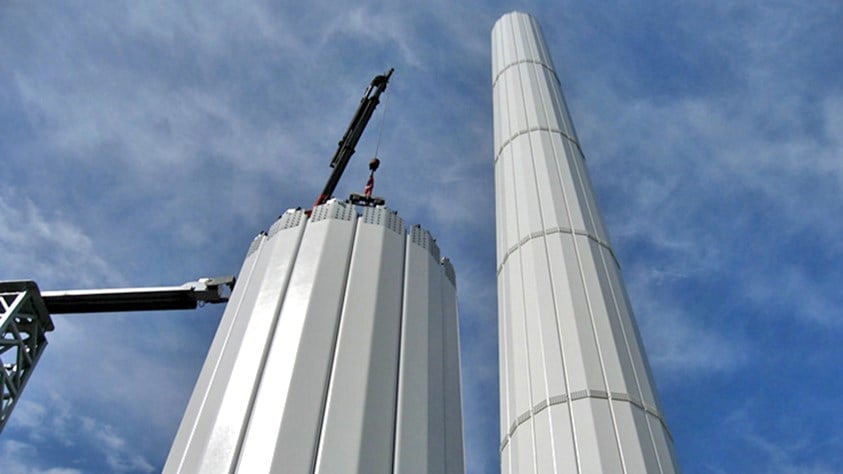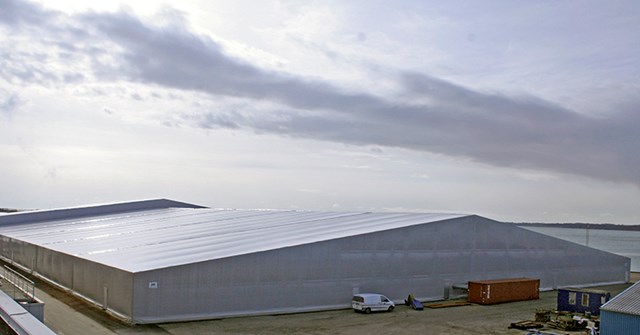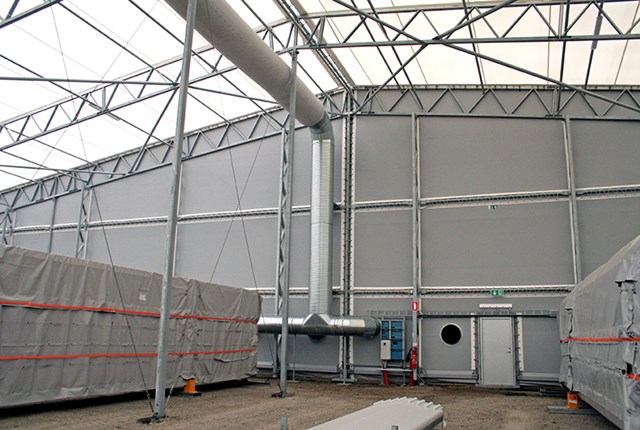Humidity control requested
A new storage facility for the wrapped and ready-to-ship shells was needed to go along with the Nyborg manufacturing plant. As an alternative to an expensive and traditional storage building, Andresen Towers chose a flexible O.B. Wiik tent storage solution that was much quicker to build.
To avoid tent storage condensation problems Siemens Wind Power requested the storage facility to be humidity controlled. Munters recommended to keep the relative humidity constantly below 60% RH. At this level condensation will be avoided and the steel parts safely stored throughout the year.
Next generation dehumidifiers selected
The tent storage supplier O.B. Wiik has extensive experience with Munters and thus included Munters dehumidification systems in the design of the 75.540m³ tent storage.
Two desiccant dehumidifiers were integrated, each with a nominal airflow of 9,500m³/h. The MX² 95 dehumidifier belongs to the new energy efficient MX² series generation, an update of the well-known robust MX desiccant workhorse, which has been installed in thousands of storage facilities all over the world.
The dehumidifiers are installed in a separate container adjacent to the tent storage. The dry air duct from each dehumidifier is lead into the storage and merges into one main duct. A 70 m long duct just below the ridge of the roof ensures an even dry air distribution within the storage. The return air circulates back to the dehumidifiers. The moisture removed from the air by the desiccant wheel is exhausted outdoors as warm, wet air.
Optimized energy efficiency
To ensure correct and low humidity levels, an electronic humidistat with wall sensors was installed. For optimized operation and energy efficiency the humidistat controls the heating elements of the dehumidifiers, operating modulating.
The rotor section in the MX² units are also equipped with an internal heat recovery module, the Energy Recovery Purge, which cuts energy consumption for regeneration of the desiccant wheel by up to 15%.
With exact and constant control of humidity in the tent storage Andresen Towers have been able to meet the demands from Siemens Wind Power and high product quality is maintained during the storage period. By installing the next generation Munters MX² dehumidifiers Andresen Towers has chosen a modern and highly energy efficient dry air solution.
Dry air storage
Over the years, dehumidification of storage facilities has been one of Munters’ main applications. Traditional methods for controlling humidity in storages normally include heating. Since most materials and products are insensitive to temperature (apart from some liquids) the heating is unnecessary and, in most cases, insufficient. But most materials are sensitive to high humidity and fluctuations in humidity, meaning an optimized storage facility should be humidity-controlled rather than temperature-controlled.
Keeping a constant humidity level at 60% RH all year round means that there will be:
-no mold or mildew
-no corrosion
-no condensation
-no building construction damage caused by high humidity
Since desiccant dehumidification operations are based on a desiccant wheel and not a cooling coil with refrigerants, dehumidification capacity remains high even at low temperatures. When the storage facility is not permanently manned heating can be completely switched of, saving up to 75% in energy costs.
Tent storage facilities are perfectly suited for humidity control with Munters desiccant dehumidifiers. The storage must be tight - just like the modern welded tent storages are - but insulation is not necessary.
In tent storage, condensation can be a problem during warm summer periods, as condensation occurs under the roof of the tent. Condensation is avoided by controlling humidity and products can be stored safely throughout the year.



